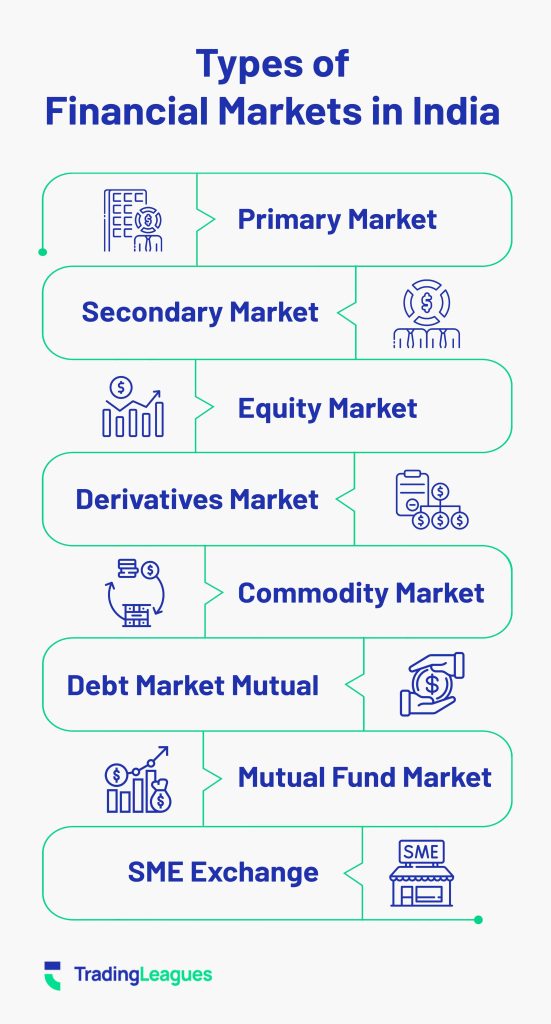When people think of the financial market, they automatically think of the ticker showing the stock prices of various companies like Reliance, Tata, etc. But many people don’t know that the secondary stock market is not the only financial market.
There are several different types of financial markets. Each market has its own purpose. When you start out as a trader or investor, it’s better to know about all of them.
That’s why we’ve brought you this short guide, explaining everything you need to know.
The Indian financial market is a very broad term that refers to several different markets. These markets include the stock market, the commodities market, the derivatives market, and so on.
The Indian financial market is governed and regulated by the Securities and Exchange Board of India (SEBI). They are responsible for ensuring that all actors in the market are playing fair and that investor interests are protected.
The size of the Indian financial market has grown significantly over the past few decades thanks to a growing economy.
Types of financial markets in India
Let’s take a look at the various types of financial markets.

Primary market
The primary market refers to the market in which securities are sold to the public for the first time. In the primary market, companies and governments can raise money from the public by selling securities such as stocks, bonds or other financial instruments.
For example, when a company undergoes an IPO (Initial Public Offering), they are selling stocks to the public for the first time to raise money. When you purchase stock through an IPO, you are buying directly from the company and participating in the primary market.
Secondary market
The secondary market refers to the market in which securities are traded between members of the public. After securities enter the market, by being sold in the primary market, they can be bought and sold any number of times in the secondary market.
The price of securities in the secondary market depends on various factors such as supply and demand, company performance, market trends, and others.
The secondary market provides crucial liquidity to investors (the ability to sell their stocks). Overall, the secondary market is essential to the economy since it allows investors to buy and sell securities, and helps the flow of capital.
Equity market
The equity market is also called the stock market. The equity market allows companies to raise capital from the public by selling ownership of the company. A “stock”, “equity”, or “share” are essentially different terms for part-ownership of a company. If you own stocks of a company, then you have a share in the ownership of the company.
The equity market can be divided into primary market and secondary market, which have been discussed above.
There are two ways in which investors can earn from equity. The first way is by price appreciation of the stock. The second way is through periodic dividends issued by the company.
Derivatives market
The derivatives market allows you to trade contracts that “derive” their value from underlying securities like stocks, commodities, currency, etc. When you trade derivatives, you don’t have to buy or sell the underlying security, but you can still gain or lose from their price movements.
There are several purposes of the derivatives market, such as managing risk, speculating price movements, and securing yourself against adverse market conditions.
Investing or trading derivatives is much more complex and risky when compared to stocks or commodities.
Commodity market
The commodity market refers to the market in which natural resources are traded. These commodities can be wheat, corn, cotton, oil, gold, silver, and others.
The commodity market can also be divided into two types. The spot market in which the actual commodity changes hands, and the derivatives market in which the actual commodity does not change hands.
The commodity market helps sellers who need to lock in the price of their goods and protect themselves against future risk. There are also speculators in the market who can profit from price changes.
Debt market
The debt market allows companies and the government to borrow from the public. Essentially, the company or government sells bonds or other asset-backed securities to the public. The public is promised repayment of the amount along with interest when the time period of the bond is over.
There are various levels of risk which exist in the debt market as well. Some types of debt instruments are considered to be less risky than others. However, debt instruments are typically less risky than equity.
Mutual fund market
A mutual fund pools money from several investors and then invests the money on their behalf. There are numerous types of mutual funds such as equity mutual funds, debt mutual funds, commodity mutual funds, index funds, and others.
When you invest in a mutual fund, the mutual fund will issue “units” to you. These units can be bought and sold like shares in the mutual fund market.
Mutual funds allow investors to take advantage of professional management of their money.
SME exchange
An SME exchange is a special type of stock exchange. The SME Exchange is specifically meant for small to medium-sized enterprises. The stocks of such companies can be bought and sold in an SME exchange.
In India, the BSE and the NSE have specialized SME exchanges (called SME Exchange and Emerge, respectively).
Wrapping up
As the economy matures, the financial markets get more sophisticated over time. In India, we are witnessing more people participating in the financial markets than ever before. Overall, the various types of financial markets benefit the economy in various ways. These markets do not just benefit the investor and trader, but also businesses and the government.






